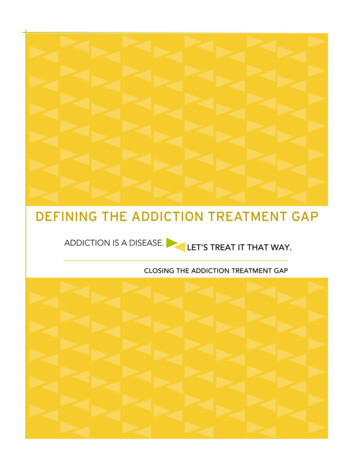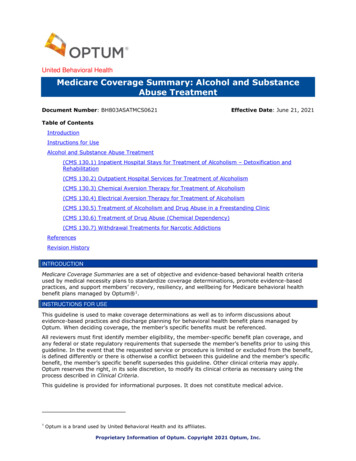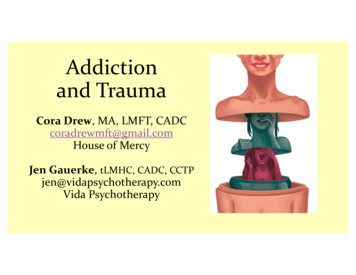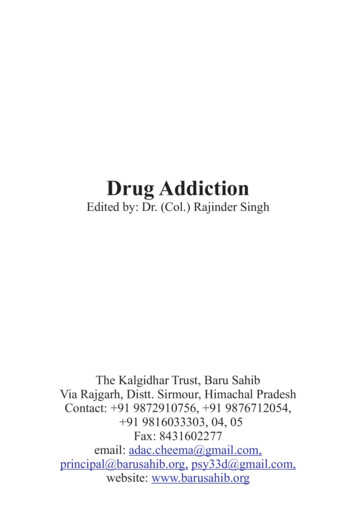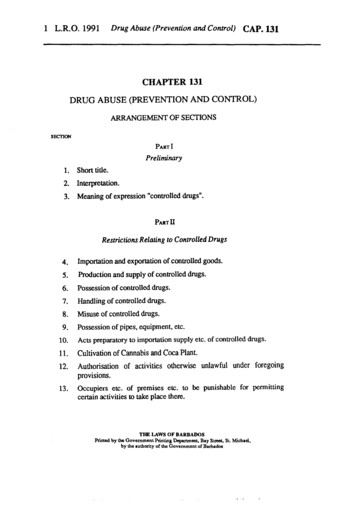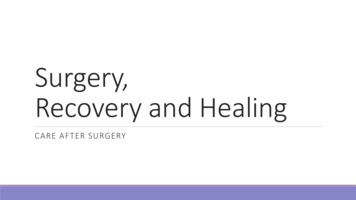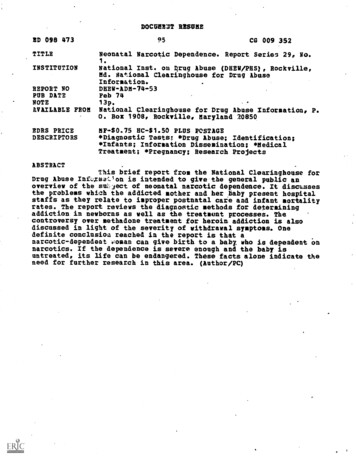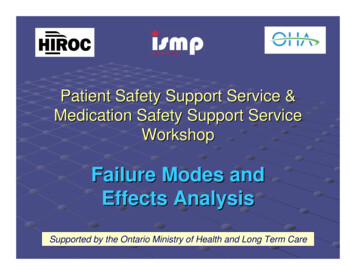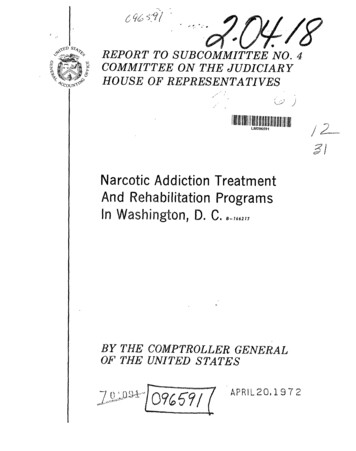
Transcription
REPORT TO SUBCOMMITT&bNV.COMMITTEEON THE JUDICIARYESENTATIVESHOUSEr’,.’.- :i I,I”,;.p4/ 6591Narcotic Addiction Treatmenttion Programs.c.B-166217--
TES20148B-166217DearMr.Chairman:In accordancewith your October15, 1971, request,the General AccountingOfficehas obtainedinformationon narcoticaddiction treatmentand rehabilitationprogramsin Washington,D.C.This is the firstin a seriesof five reportsto be issuedpursuantto your request.Otherreportswill coverthe citiesof New York,N.Y.;Chicago,Illinois;and San Franciscoand Los Angeles,California.We have discussedthe contentsministratorof the DistrictIsNarcoticsand his staff.Theircommentshaveport.of this reportwith the AdTreatmentAdministrationbeen incorporatedinto the re-We plan to make no furtherdistributionof this reportunlesscopiesare specificallyrequested,and then we shall make distributiononly afteryour agreementhas been obtainedor publicannouncementhas been made by you concerningthe contentsof ther epo rt.Sincerelyyours,Comptrollerof the UnitedThe HonorableDon Edwards61 -VP.& airman,SubcommitteeNo.Committeeon the JudiciaryHouseof Representatives4#IT@’GeneralStates
ContentsPageDIGEST1CHAPTER1INTRODUCTION2NARCOTICS TREATMENTADMINISTRATIONProgram goalsTreatment modalitiesPatientsin treatmentand servicesavailableSource of fundingTreatment cost of various modalitiesCriteriaused to select patientsfortreatmentProgram assessment effortsProgram resultsResults achieved by NTA adult programsResults achieved by NTA youth programsResults achieved by NTA contractors345ADDITIONAL INFORMATION ON NTA PROGRAMRESULTS AND NTA DATA COLLECTION SYSTEMProgram resultsat the Youth CenterProgram resultsat the Community Addiction Treatment CenterNTA data collectionsystemPROBLEMSAT TREATMENTCENTERS IN THE DISTRICT OF COLUMBIAStaff and staff trainingSupportiveservicesPhysical facilitiesINFORMATION ON OTHER TREATMENTPROGRAMSRECEIVING GOVERNMENTFUNDSSaint ElizabethsHospital--LastRenaissanceVeterans 313336363738404041
PageCHAPTERNarcoticAddict RehabilitationD.C. Department of Correctionsrelease program-- Residentialment CenterActworkTreat-4346APPENDIXIIIIIILetterdated October 15, 1971, from Chairman, Subcommittee No. 4, House Committeeon the JudiciaryNarcoticsTreatment AdministrationtreatmentcentersCommunity AddictionTreatment CenterCriminalJusticeSurveillanceUnitDrug AddictionMedical Service--ClinicDrug AddictionMedical Service--Inpatient UnitsEmerge HouseDetoxification-AbstinenceClinicFar East AddictionTreatment ServiceG Street ClinicModel CitiesAddictionTreatment ProgramNarcoticAddict RehabilitationCorpsNarcoticAddict RehabilitationCorps-ClinicYouth CenterNeighborhood Treatment CenterSoutheast Neighborhood Action Board-Adult ProgramSoutheast Neighborhood Action Board-Youth ProgramBonabond Step-oneIndicatorsof the size of the District'saddictionproblemEstimatesof number of narcoticaddictsNarcoticarrestsReported by Metropolitan Police DepartmentNumber of Addicts Appearing Before Districtof Columbia Superior Court47484848484849494950505051515252535354545657
PageAPPENDIXNarcoticoffendersat the DistrictjailBureau of Narcoticsand Dangerous Drugslistof known addictsand estimateoftotaladdictsIVMap of narcoticaddict treatmentcussed in this reportcentersBlackman'sDevelopmentCATCCommunity AddictionDAMSDrug dictNTC-RTC eOfficeRehabilitationCorpsTreatment Center Treatment ard
.COMPTROLLERGENERAL'SREPORTTO SlJBCO&iUTTEENO. 4COMUTTEE ON THE JUDICIARYHOUSEOF REPRESENTATIVESNARCOTIC ADDICTION TREATMENTAND REHABILITATIONPROGRAMSIN WASHINGTON, D.C.B-166217DIGEST------WHYTHE REVIEW WASMADEThis is the firstof fivereportsrequestedby the Chairmanof the Subcommitteeon programsfor treatmentand rehabilitationof narcoticaddicts.This?@&%concernsprogramsin Washington,D.C.Other reportswill-coverprogramsin New York, N.Y.;Chicago,Illinois;and San Francisco and Los Angeles,California.The Generaldata onAccountingOffice--theamount of money spenttreatmentand rehabilitation--numbers--goalsof addictsoftheto measure--effortsby sponsorsaskedto obtainby reachcityon narcotictypesoftreatment,programs,--criteriaGAO was notbeing(GAO) was askedaccomplishmentsto measureto programs.performance.The Subcommitteeis concernedthat,in developinglegislationfor narcotictreatmentand rehabilitationprograms,adequateprovisionbe madefor assessmentof the programsso thatthe Congressand the executiveagencieswillhave a basison which to take actionto improvethe programs.FINDINGS AND CONCLUSIONSThe number of narcoticaddictsin the Districtof Columbiahas been estimatedat 20,000.The number of narcoticaddictsis difficultto determinefor any area becausethereis no accepteddefinitionof the term"narcoticaddict,"no reliableor completereportingsystem,and no meansof identifyinga person as an addictunlesshe is arrestedor enrollsina treatmentprogram.TreatmentAdministration(NTA) carriesout most of the ad-'/P 761I The Narcotics' dictiontreatmentprogramsin the Districtof Columbia.The agency wasorganizedin February1970 as a part of the D.C. Governmentto lead andTearSheet1APRfL2QJ9T2
coordinatea comprehensivecommunityeffortagainstthe problemof heroinaddiction.NTA providesservicesthrough12 treatmentcentersit operatesand throughfour centersoperatedby contractswith. privateorganizations.Since February1970, NTA has receivedFederalsupporttotalingabout 12.3 million.(See p. 15.)NTA has setfourprimarygoalsintreatingand rehabilitating--Assistthe addictin findingproductive--Stopillegaldrug use.--Eliminatecriminalbehavior.--Keepthe addictunder treatment.employmentaddicts.or jobtraining.NTA has initiatedseveralstudiesto determinehow well its programsareachievingthese goals.NTA periodicallycollectsdata on employmentstatus,urinalyses,arrestrecords,and durationof treatmentfor each patientin the studies.This data is summarizedand evaluatedat 6-monthintervals.Resultsofthestudyafter18 monthsshowed:--For450 adultpatients,that 84 (19 percent)met all programgoals and that124 additionalpatients(27 percent)had beenment for 18 months but had failedto meet one or more of thegoals.Employmentposed the largestproblem.(See p. 22.)--For150 youthpatients,thattwo (7 percent)met allment goals and that18 additionalyouths(12 percent)treatmentbut failedto meet one or more of the other(See p. 24.)NTA researchNTA alsotractors.studiesarediscussedhas conductedstudies(See p. 26.)inofthedetailon pageresultsbeingtreatmentin achievedby itsNTA's data collectionsystem is being expandedto includea numbernew reportssummarizingdata for all patientsat a treatmentcenterfor allNTA patients.GAO believesthatthe data in these reportsprovidea means for continuallyassessingprogramresults.To obtainprograms,patients.additionalinformationGAO analyzedreported(See pp. 29 and 31.)on the resultsinformationforof NTA'sselectedcon-ofandshoulddrug treatmentgroupsof NTAGAO visitedallthe treatmentcentersoperatedby NTA and its contractorsto obtaininformationon problemsand needs of the centersand waysto improvethe drug treatmentprogram.Accordingto programadministrators,counselors,and patients,NTA needs include:--Additionaland bettertrainedtiveservicesto patients.staff2membersto providemoreeffec-
for patients.physicalfacilities.such(Seech.as jobplacement,training,and4.)AGENCYCOitMENT.5'The Administratorof NTA told GAO that,duringNTA's 1st year of operation,emphasiswas placedon growthand that as many patientsas possiblewere enrolledin treatmentprograms.Duringits 2d year,NTA'sgrowthrate was lower and its effortswere concentratedon broadeningservicesto its patientsand restructuringmany treatmentcenters.In the 1st year most treatmentcentersDuringthe 2d year many offeredalltypes of treatment.to specializein one type of treator detoxification.Currently,accordingto the Administrator,NTA is becomingincreasinglyconcernedaboutthe totalhuman needs of each patient.NTA attemptstomeet as many of the patient'sneeds as possibleat the treatmentcenters.it acts as a "broker"to arrangeforWhen NTA vicesto be providedby otheragencies.that NTA never shouldexpectto meet allthe needs of its patientsbecause to do so would involveduplicatingmany socialservicefunctionsprovidedby edGAOthat manyness.HeprofessionalsTear--- - Sheetmostof NTA's counselorsare ex-addicts.The Administratorthat more and bettertrainedcounselorswere needed.He adthatex-addictcounselorsusuallywere effectivebut indicatedof them resistedtrainingwhich would increasetheireffectivestatedthatNTA needed to work on thisproblemand to hire moreas counselors.
CHAPTER1INTRODUCTIONOur Nation today is faced with a serious narcoticadThe President,in his January 20, 1972,dictionproblem.state of the Union message, remarked that:"A problemconcern toanguish toincreasingour Nation'scharacter."of modern life which is of deepestmost Americans--andof particularmany-- is that of drug abuse.Fordependence on drugs will surely sapstrengthand destroy our Nation'sIn a June 17, 1971, message to the Congress, thePresidentdescribed the nature of the drug problem, as follows:"Narcoticaddictionis a major contributor,tocrime.The cost of supplying a narcotichabitcan run from 30 a day to 100 a day.This is 210 to 700 a week, or 10,000 a year to over 36,000 a year.Untreated narcoticaddicts donot ordinarilyhold jobs.Instead,they oftenturn to shoplifting,mugging, burglary,armedrobbery,and so on. They also support themselves by startingother people--youngpeople-on drugs.The financialcosts of addictionare more than 2 billionevery year, but thesecosts can at least be measured,Thehumancosts cannot.American society should not berequiredto bear eithercost."Throughout the Nation questionsare being asked concerning the most effectiveway to deal with this problem.Standards settingforth the resultsexpected from treatmentand rehabilitationprograms are vague, and frequentlythereare no standards.Results of various methods of treatmentare debated by experts.Data on the number of addicts inthe Nation is based on educated guesses, at best.Data onpeople in treatmentthroughoutthe country generallyis lacking as is data on program costs and resultsachieved.5
Because of the seriousnessof the narcoticaddictionproblem and the need for informationto arriveat rationaldecisions,the Chairman, Subcommittee No. 4 of the HouseCommittee on the Judiciary,requested GAO to assist theCongress in obtaininginformationon the progress being madeThe Subcommitteein the rehabilitationof narcoticaddicts.Chairman asked that GAO's review include programs receivingFederal,State, or local funds in five cities--Washington,New York, Chicago, Los Angeles, and San Francisco--andthatindividualreports be prepared for each.GAO was asked to obtain for each city data on theamount of money being spent by Federal,State, and localagencies on narcoticrehabilitationprograms and the extentof program assessment effortsbeing made by the fundingagencies.GAO was not asked to evaluate program performance.The Subcommittee is concerned that,in developing legislationrelatedto the treatmentand rehabilitationofnarcoticaddicts,adequate provisionbe made for programassessment effortsso that the Congress and the executiveagencies will have a basis for taking action to improve theprograms.This report is concerned with treatmentand rehabilitation programs for narcoticaddicts in the Districtof Columbia funded by the D.C. Government; the Department of Health,Education,and Welfare;the Department of Justice;the Office of Economic Opportunity;and the Veterans Administration.Locationsof treatmentcenters are shown on the mapin appendix IV.Treatment agencies not receivingGovernmentfunds were not included in our review.In February 1972 there were nearly 3,800 narcoticaddicts receivingtreatmentin programs supported with FederalThe amount of funds provided for these proor D.C. funds.grams by the Federal or the D.C. Government was about 5.9 millionfor fiscalyear 1971. About 4.7 millionofthese funds were availablefor programs administeredbyHTA.According to NTA there were approximately20,000 narcotic addicts in the Districtof Columbia as of6
September 30, 1971.NTA officialsadmit, however, thatthey cannot attestto the reliabilityof the estimate betechnique decause it is based, in part, on an estimatingveloped in New York City which may have no applicabilityorvalidityin the District,and, in part, on several othertechniques which rely on a number of unproven assumptionsand relationships.The task of determiningwith any degree of reliabilitythe number of narcoticaddicts in the District,or in anyother area, is made extremelydifficultbecause there is nocommonly accepted definitionfor the term "narcoticaddict,"no reliableor complete reportingsystem, and no means ofidentifyinga person as a narcoticaddict unless he is arThe methods usedrested or enrollsin a treatmentprogram.by NTA to estimate the number of narcoticaddictsin thecity and certainother indicatorswhich provide some insightinto the size of the District'saddictionproblem are discussed in appendix III.An estimate of the annual cost of heroin addictioninthe Districtis provided by a November 1970 report entitled"The Economics of Drug Addictionand Control in Washington,D.C. ," prepared by the District'sDepartment of Correctionsthrough its Office of Planning and Research.The reportestimatedthat the annual cost of heroin addictionin theThis representsan estiDistrictmight exceed 200 million.mated outlay of (1) 175 millionfor the illegalacquisitionof heroin by addicts,(2) 8 millionfor police and courtcosts, (3) 9 millionfor jailand parole expenses, and (4) 13 millionin earnings lost to those addicted to heroin.The 175 millionestimate was based on the assumptionthat there were 15,000 addicts in the Districtand that thecost of an average heroin habit in the Districtat that timewas about 40 a day. The daily cost of an average heroinhabit was based on informationobtained by NT.A from residentsof the District'sjail during a study conducted in Augustand September 1969.The report states that addicts finance their habitsthrough a combinationof means which include (1) "pushing'for sellingdrugs, (2) prostitution,(3) obtainingfunds fromfamily or relatives,(4) working in legitimate,though7
low-wage,addiction,occupations,especiallyin the early stagesand (5) burglary,larceny,and robbery.ofThe Department'sreport states that, to estimate theamount of propertyand money that heroin addicts must stealto support their habits,several assumptions must be madeas to how addicts obtain heroin and as to the sources offunds availableto heroin addicts.These assumptions,according to the report,are based on discussionswith program officialsand not on the empiricalresearch which isessentialfor reaching valid conclusions.It was assumed in the report that 20 percent of allheroin consumed by the addict populationis obtained bypushing.The report points out that this does not mean that20 percent of all addicts are pushers but that 20 percentof the heroin used by addicts is obtained for servicesrendered in the distributionsystem.forThe report has assumed, concerningheroin purchases,that:the fundsrequiredrobbery,1. 60 percent are obtainedand larceny.throughburglary,2. 15 percentare obtainedthroughlegitimate3. 15 percentare obtainedthroughprostitution.4. 10 percent are obtainedtivity,such as forgery,games.sources.through other illegalacauto theft,and confidenceIt was assumed also that, of the amount20 percent would be stolen money and 80stolen propertythat could be convertedproximatelyone third of the property'sgained by theft,percent would beto money for apvalue.On the basis of these assumptions,the November 1970report showed that, to obtain the 175 millionneeded annually by 15,000 addicts to support their habits,the addictswould steal cash and property valued at 273 millionandwould obtain 22 millionthrough other illegalactivities,such as forgery,auto theft,and confidencegames; 33 million through legal activity;and 33 millionthrough prostitution.8
CHAPTER 2NARCOTICS TREATMENTADMINISTRATION--NTA was establishedwithinthe Department of Human Resources, Districtof Columbia, in February 1970 to lead andcoordinatea comprehensive community effortto cope withthe problem of heroin addictionin the District.The Administratorof NTA informed us that, during NTA's 1st yearprimary emphasis was placed on enrollingasof operation,many patientsas possible and that a varietyof treatmentmodalitieswas offeredat all treatmentcenters.DuringNTA's 2d year of operation,the rate at which new patientswere added slowed down and NTA began to expand its servicesfrom a medicallyorientedmode of operationto a more comprehensive approach designed to meet patients'totalneedseducation and job placement,etc.).As( i.e., treatment,part of this broadening process, NTA adopted the concept ofspecializedcenters which offered one primary modalityoftreatment.NTA's stated objectivesare to provide comprehensiveand effectivetreatmentfor all addictsin the District,tocarry out research to increase the understandingof heroinaddiction,and to advance a major educationaland preventiveprogram aimed at reducing the recruitmentof new heroinaddicts.Our review consideredonly the treatmentprogramsof NTA, not its research and education programs.As requested by the Chairman of the Subcommittee,obtained the followinginformationon NTA's treatmentrehabilitationprograms.--Program goals.--Treatmentmodalities.--Patientsin treatmentand servicesavailable.--Source of funding.--Treatmentcost of various modalities.--Criteriaused to select patientsfor treatment.--Program assessment efforts.--Program results.weand
PROGRAMGOALSNTA has fourprimarygoalsforall--Productiveand self-fulfillinga job or nof illegalpatients.socialfunctioningindrug use.of criminalactivity.in treatment.TREATMENTMODALITIESNTA operates 12 treatmentcenters throughoutthe city,includinginpatientand outpatientcenters and a surveillance unit for persons who must demonstrate that they canremain drug free as a conditionof their probationor parole.In addition,NTA has contractswith community-based privateagencies to provide services for heroin addicts at fourother centers.Two of the 16 centers provide both inpatientand outpatientservices,two provide only inpatientservices, and the other 12 are outpatientcenters.Most ofthe centers offer one predominantmodalityof treatmentinkeeping with NTA's present operatingconcept of specializedclinics,NTA's program design makes extensive use of methadonetreatment,Methadone is an addictivesyntheticnarcoticwhich shares many pharmacologicpropertieswith morphine,heroin,and other opiate drugs.Methadone, when used totreat chronic heroin addiction,has several unique properA single dose, taken orally,suppresses withdrawalties.symptoms in a heroin-dependentperson for 24 to 36 hours.If given in large enough doses, it also blocks the euphoriceffectsof heroin.Additionally,methadone-addictedperdo not continuallyneed insons, unlike heroin addicts,creasinglylarger quantitiesto prevent withdrawaleffects,once their daily doses are in the range of 40 to 80 milligrams of methadone a day.Generalcategoriesof treatment,are:10as definedby NTA,
--Abstinence--forpatientsbut needing the supportmonitoring.attemptinga drug-freeof counselingand urinelife--Methadone detoxification--forpatientsdesiringtowithdraw from physicaladdictionwith minimal disDecreasing dosages of methadone are givencomfort.on an inpatientor outpatientbasis.Methadonedetoxificationperiods are scheduled to range from2 weeks to 6 months but may be extended beyond6 months, depending on patientneeds.--Methadone maintenance--foreligiblecandidatesusually at least 18 years old with a minimal 2-yearhistoryof heroin addictionwho voluntarilyconsentDaily stabilizationdoses of methadoneto treatment.which satisfythe craving for heroin and block itseffectsare given over a prolonged period of time.--Methadone hold--forimmediate treatment,with metha&ne, of walk-inpatientsprior to determinationwithin no more than 2 weeks of the most appropriatetreatmentregimen after complete examination,diagnosis, and redfor druguse evaluationorneedingto demonstratethat theycan remain drug free for a specifiedperiod of time,i.e.,awaitingcourt action or validationof a motorvehiclelicense.NTA's methadone maintenance clinicsare designatedasinductionor stabilizationclinics.There is only one induction clinic.This clinicserves new methadone maintenance patientswho requirefrom 4 to 6 weeks to becomestabilizedon blockingdoses of methadone.The inductionclinicoperates 7 days a week because new patientsmusttake their methadone at the clinicand do not have takehome privileges.Once stabilized,the patientis transferred to a stabilizationclinicwhere there is less contact with the clinicand the patientis allowed weekendtake-home privilegesfor methadone,Stabilizationclinicsoperate on a 5-day week. As treatmentprogresses and the11
patientbecomes more advanced in the program, secures asteady job, uses no illegalfitsintodrugs, and generallysociety as a functionalcitizen,he may take home as muchas a 3-day supply of methadone.12
PATIENTS IN TREATMENTAND SERVICES AVAILABLEAny residentof the Districtof Columbia who is foundto be a narcoticaddict is admitted by NTA for treatment.In addition,we were advised by NTA that there is no waitBrieflyduring the spring and suming listfor treatment.mer of 1970, intake proceedings had to be stopped becausefacilitieswere full,As soon as this situationwas remedied, people were again admitted to treatmenton a firstcome-first-servedbasis.Within the first2 years of its operation,the numberof patientsenrolledin NTA treatmentprograms grew considerably.In February 1970 NTA had 153 patientsin treatment.The followingtable shows the treatmentmodalityforall 3,506 reportablepatientsat NTA or contractorcentersas of February 4, 1972.wandContractorAs of FebruaryPatientCount4. 1972ModalitySsti-Mainte-DetoxifinanceNTA us:iceSurveillanceUnitDrug AddictionMedicalServiceClinicDrue AddictionMedicalService--inpatientEmerge HouseDetoxificatron-AbstinenceClinicFar East AddictionTreatmentSerx.iceG StreetClinicModel ilitatlonCorksNarcoticAddictClinicYouth theastNeighborhoodyouthBonabond 31and79TotalTotalPercentageofNTA and A200-106centers3,506z2,256treatmentgo %g65%-Services availablesuch factorsas staffing,itationsof the facility,1at centers differ,depending onpatientcase load, physicallimand the needs of the patients.139
All centers offer individualcounseling and utilizeurinetestingto determine illegaldrug use.Observed urine specimens are usuallytaken two times a week.Most centers also offer some supportiveservicessuchas job placement,education and trainingassistance,healthservices,financialaid, and assistancehousing assistance,in obtainingfurnitureand clothing.The extent to whichsuch services are provided depends on the availabilityofstaff,We noted that some centers have individualstaffmembers who specializein job placement or education andtraining,but most often all of these functionsmust be performed by the counselingstaff in additionto their regularduties.In addition,centers are requiredto perform anoutreach functionto seek out patientswho have dropped outof the program and to persuade them to return to treatment.The extent to which the outreach functionis performed depends on staff availability.Services availablecenters are more fullyat each of the NTA and contractordiscussed in appendix II.14
SOURCEOF FUNDINGSince its organizationin Februaryceived the followingfinancialsupport.Districtof Columbia appropriation:Directlyto NTAIndirectlythrough the Department of CorrectionsTotalappropriatedFederal grants:Office of Economic OpportunityDepartment of Housing andUrban DevelopmentNationalInstituteof MentalHealthIaw Enforcement AssistanceAdministrationTotalgrantsGrand total1970, NTA has re-Total1970 4,914,200 354,0001,386,500240.400 6.300.700 594 , 400Fiscal Year1971 2,690,200417,300 3.107,5001972 1,870,000728,800 ,334,700TREATMENTCOST OF VARIOUS HODALITIESWe were unable to obtain actual per patientcost datafor the various treatmentmodalitiesbecause NTA does notaccumulate costs on a treatment-centerbasis.We asked NTAofficialsto provide us with estimatedper patientcostsfor the various methods of treatment.Since many of thetreatmentcenters operated by NTA offer a combinationoftreatmentmethods and services,it was necessary for NTA todevelop models for typicaltreatmentcenters.NTA chose todevelop models for a methadone maintenance center,adetoxification-abstinencecenter,and a halfway house.The methadone maintenance and detoxification-abstinencemodels provided for average staffingpatterns,averagesalary and benefitpayments, and estimatesof such otheroperatingexpenses as travel,equipment,rent, supplies,methadone, and urinalysis.The models also consideredtheestimatedcost of administrativeoverhead for Department of!%man Resources personnel.15
The model for the halfway house consistedof a typicaloperatingbudget for the residentialcenter 'at 456 C Street,Northwest,which is a halfway house for patientsreferredby the criminaljusticesystem.Estimates were included inthe budget for NTA centralizedtreatmentsupport and forDepartment of Human Resources overhead.NTA estimatedfollows:Treatment methodOutpatient methadonemaintenanceOutpatient detoxificationabstinenceResidentialltalfway houseaverageTotalannualDirectper patientAnnual per patientNTATreatment administrativesupportdirectioncosts,ascostsDept. ofHuman Resourcesoverhead 1,001 655 150 110 862,0326,2251,3084,096300938220688208503It should be noted that the operatingcosts of thehalfway house may be higher than the operatingcosts of halfway houses in other programs around the country because thepatientsbeing treated in the NTA model are parolees fromcriminalinstitutionsover whom NTA has been assigned cusMore staff is requiredto maintain custody over thesetody.people than is requiredat halfway houses where patientsareadmitted voluntarilyand are free to leave at any time.The Administratorof NTA suggested that it would bemeaningfulto compare the cost of treatingaddicts with theoncost to society of not treatingthem. As indicatedpage 8, the Department of Correctionsestimated thatannually15,000 addicts steal cash and property valued at 273 million and obtain another 22 millionthrough such other illegalactivitiesas forgery,auto thefts,and confidenceThisamountstoanapproximate 20,000annual lossgames.to society caused by each addict'scriminalactivitjes.A comparison of the estimated'lossto the cost of treating an addict,assuming that the cost estimatesare validand the addict'scriminalactivitiesare reduced duringwould suggest that the cost of treatmentis er,worthwhile.16
because we did not verifythe validityof the estimatedcost of treatmentor the estimatedcost to societyfrom untreated heroin addictionand because we did not obtain complete informationon the extent of addicts'criminalactivitiesbefore and after entry into treatment.17
CRITERIA USED TO SELECTPATIENTS FOR TREATMENTAny residentof the Districtof Columbia is eligibleAllapplicantsfor treatmentby NTA,for treatmentby WA.whether voluntaryor court-recommended,are examined andprocessed at one centralintake facility.Basically,thiscentralfacilityconsistsof a medical section and aThe nded through a grant from the Law Enforcement AssistanceAdministrationof the Department of Justice.The medical sectionis responsiblefor performingaphysicalexamination,which includes blood studies,urinalysis, X-rays,and electrocardiograms,and for obtainingamedical historyof each applicant.The counseling-intakesection,in additionto confirming an applicant'sage, identification,and referralsource,is responsiblefor counselingand assistingeach applicant.Counselors ensure that each person becomes familiarwith theprogram and understandsthe servicesavailablefrom NTA,includingthe role of methadone in the controlof drug abuse.Each new applicantis extensivelyinterviewedby acounselor who obtains and records informationon employment,educational,military,criminal,and social histories.Anextensivedrug-abuse history,includinga medical opinionas to the extentof drug abuse, is also completed for eachapplicant.A decisionas to the appropriatetreatmentmodalityis made jointlyby the counselor and the patient.Physiciansare availablefor consultationin this process.Afterthe treatmentmodalityis agreed on (methadone maintenance, methadone detoxification,or abstinence),the patientis sent to the appropriateNTA treatmentcenter.Asummarizationof importantsocial and medical needs of thepatientis sent to the treatmentcenter by the intake unit.At the treatmentcenter
Detoxification-Abstinence Clinic Far East Addiction Treatment Service G Street Clinic Model Cities Addiction Treatment Pro- . methadone maintenance, or detoxification. Currently, according to the Administrator, NTA is becoming increasingly . Chicago, Los Angeles, and San Francisco--and that individual reports be prepared for each. GAO was .

